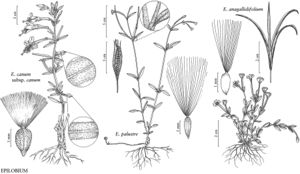Epilobium palustre
Sp. Pl. 1: 348. 1753.
Herbs with multiple filiform epigeous stolons with widely spaced, small leaves, terminating in condensed, dark, small turions 3–7 × 2–3 mm. Stems erect, loosely clustered, terete, 5–80 cm, simple to well branched, subglabrous on proximal internodes, sometimes with faint strigillose lines decurrent from margins of petioles, densely strigillose distally. Leaves opposite proximal to inflorescence, alternate distally, subsessile; blade lanceolate or narrowly elliptic to sublinear, 1.5–7 × 0.2–1.9 cm, base cuneate, margins entire or inconspicuously denticulate, 2–6 teeth per side, veins inconspicuous, apex acute or acuminate, surfaces strigillose abaxially, subglabrous adaxially or strigillose only on margins and veins; bracts smaller and narrower. Inflorescences nodding in bud, later erect, racemes, not branched, densely strigillose, rarely mixed sparsely glandular puberulent. Flowers erect to spreading; buds 2–5 × 1.5–2.5 mm; pedicel 8–12 mm; floral-tube 0.6–1.8 × 1.3–2.2 mm, ring of spreading hairs at mouth inside; sepals 1.4–4.5 × 0.8–1.5 mm, abaxial surface strigillose; petals usually white, rarely pink, 2–9 × 1.8–5 mm, obcordate, apical notch 0.6–1.6 mm; filaments cream or white, those of longer stamens 0.8–3.5 mm, those of shorter ones 0.4–2.1 mm; anthers 0.4–1 × 0.3–0.7 mm; ovary 12–35 mm, strigillose; style cream, 1.5–4.5 mm, stigma clavate to cylindrical, entire, 0.8–2 × 0.5–1.4 mm, usually surrounded by, rarely exserted beyond, anthers. Capsules straight or upcurved, 25–90 mm, surfaces strigillose; pedicel 15–35 (–60) mm. Seeds elliptic, attenuate to narrowly fusiform, 1.4–2.2 × 0.4–0.5 mm, chalazal collar 0.1–0.25 mm, conspicuous, surface finely papillose; coma persistent, white, 5–7 mm. 2n = 36.
Phenology: Flowering Jul–Sep.
Habitat: Low, boggy areas, swamps, saturated stream banks, mossy meadows.
Elevation: 0–1000(–2600) m.
Distribution
Greenland, St. Pierre and Miquelon, Alta., B.C., Man., N.B., Nfld. and Labr., N.W.T., N.S., Nunavut, Ont., P.E.I., Que., Sask., Yukon, Alaska, Calif., Colo., Conn., Maine, Mass., Mich., Minn., Mont., N.H., N.J., N.Y., Oreg., Pa., R.I., S.Dak., Utah, Vt., Wis., Wyo., n, c Eurasia
Discussion
Epilobium palustre is an extremely widespread circumboreal species that is relatively common from Alaska across Canada, especially around the Great Lakes to the Maritime provinces (mostly below 1000 m). This species is somewhat less common in the northeastern United States, and only scattered in the mountains of the western United States, south to California and Colorado (to 3000 m). It also occurs in ice-free regions of Greenland south of 70º north latitude, in northern and central Europe, across most of subarctic Russia to the Caucasus, the Himalaya complex, and eastern Asia, including Japan and the Russian Far East.
Epilobium palustre shows considerable variation across its very wide distribution and, not surprisingly, distinctive local races, which sometimes have been named formally, including several from northeastern North America. Within series Palustriformes by C. Haussknecht (1884), M. L. Fernald (1944d) clarified much confusion in names at that time, clearly delineating and establishing the nomenclature of E. davuricum, E. leptophyllum, E. palustre, and E. densum. Fernald also recognized E. nesophilum (see discussion under 18. E. leptophyllum) and E. pylaieanum, the latter based on small plants of E. palustre from southern Newfoundland.
Epilobium lineare Muhlenberg and E. palustre var. albiflorum Lehmann are illegitimate names that pertain here.
Selected References
None.
Lower Taxa
"narrower" is not a number.
